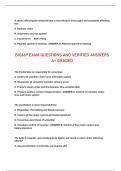Bio 669 cardiac - Study guides, Class notes & Summaries
Looking for the best study guides, study notes and summaries about Bio 669 cardiac? On this page you'll find 32 study documents about Bio 669 cardiac.
Page 3 out of 32 results
Sort by

-
BIO 669 Quiz 4- Cardiovascular Questions and Answers latest 2022/2023,100% CORRECT
- Exam (elaborations) • 37 pages • 2022
-
- $15.99
- + learn more
BIO 669 Quiz 4- Cardiovascular Questions and Answers latest 2022/2023 1. Which of the following conditions is the most immediately at risk for serious complications? a. Unstable angina b. Prinzmetal angina c. STEMI d. NSTEMI 2. Thromboangiitis obliterans (Buergers disease) is an autoimmune condition that is: a. A result of over activation of the intrinsic and extrinsic clotting system systemically b. Characterized by attacks of vasospasm in the small arteries and arteri...

-
Bio 669 Quiz 4 Study Questions with Correct Answers 100% Verified and Graded A+
- Exam (elaborations) • 6 pages • 2024
- Available in package deal
-
- $8.99
- + learn more
Bio 669 Quiz 4 Study Questions with Correct Answers 100% Verified and Graded A+ Which of the following conditions is the most immediately at risk for serious complication - Correct Answer STEMI Thromboangiitis obliterans (Buerger disease) is an autoimmune condition that is - Correct Answer strongly associated with smoking which of the following is not a systemic disease that is associated with Reynaud's phenomenon - Correct Answer congestive heart failure rheumatic fever and subsequen...
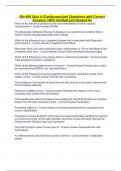
-
Bio 669 Quiz 4 (Cardiovascular) Questions with Correct Answers 100% Verified and Graded A+
- Exam (elaborations) • 6 pages • 2024
- Available in package deal
-
- $8.99
- + learn more
Bio 669 Quiz 4 (Cardiovascular) Questions with Correct Answers 100% Verified and Graded A+ Which of the following conditions is the most immediately at risk for serious complications? - Correct Answer STEMI Thromboangitis Obliterans (Buerger's disease) is an autoimmune condition that is: - Correct Answer Strongly associated with smoking Which of the following is not a systemic disease that is associated with Raynaud's phenomenon? - Correct Answer Congestive heart failure Rheumatic fe...
BIO 669 BUNDLED EXAMS WITH QUESTIONS AND 100% CORRECT ANSWERS...
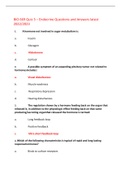
-
BIO 669 Quiz 3 – Endocrine Questions and Answers latest 2022/2023,100% CORRECT
- Exam (elaborations) • 22 pages • 2022
-
- $15.99
- + learn more
BIO 669 Quiz 3 – Endocrine Questions and Answers latest 2022/2023 1. A hormone not involved in sugar metabolism is: a. Insulin b. Glucagon c. Aldosterone d. Cortisol 2. A possible symptom of an expanding pituitary tumor not related to hormones includes: a. Visual disturbances b. Muscle weakness c. Respiratory depression d. Hearing disturbances 3. The regulation shown by a hormone feeding back on the organ that released it, in addition to the physiologic effect ...
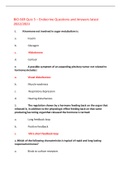
-
BIO 669 Quiz 3 – Endocrine Questions and Answers latest 2022/2023,100% CORRECT
- Exam (elaborations) • 22 pages • 2022
-
- $15.99
- + learn more
BIO 669 Quiz 3 – Endocrine Questions and Answers latest 2022/2023 1. A hormone not involved in sugar metabolism is: a. Insulin b. Glucagon c. Aldosterone d. Cortisol 2. A possible symptom of an expanding pituitary tumor not related to hormones includes: a. Visual disturbances b. Muscle weakness c. Respiratory depression d. Hearing disturbances 3. The regulation shown by a hormone feeding back on the organ that released it, in addition to the physiologic effect ...
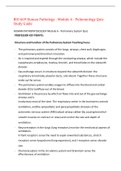
-
BIO 669 Human Pathology - Module 6 - Pulmonology Quiz Study Guide,100% CORRECT
- Exam (elaborations) • 61 pages • 2022
-
- $15.99
- + learn more
BIO 669 Human Pathology - Module 6 - Pulmonology Quiz Study Guide HUMAN PATHOPHYSIOLOGY Module 6 - Pulmonary System Quiz PROFESSOR KEY POINTS: Structure and Function of the Pulmonary System Teaching Focus • The pulmonary system consists of the lungs, airways, chest wall, diaphragm, and pulmonary and bronchial circulation. • Air is inspired and expired through the conducting airways, which include the nasopharynx, oropharynx, trachea, bronchi, and bronchioles to the sixteenth divis...
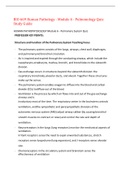
-
BIO 669 Human Pathology - Module 6 - Pulmonology Quiz Study Guide,100% CORRECT
- Exam (elaborations) • 61 pages • 2022
-
- $15.49
- + learn more
BIO 669 Human Pathology - Module 6 - Pulmonology Quiz Study Guide HUMAN PATHOPHYSIOLOGY Module 6 - Pulmonary System Quiz PROFESSOR KEY POINTS: Structure and Function of the Pulmonary System Teaching Focus • The pulmonary system consists of the lungs, airways, chest wall, diaphragm, and pulmonary and bronchial circulation. • Air is inspired and expired through the conducting airways, which include the nasopharynx, oropharynx, trachea, bronchi, and bronchioles to the sixteenth divis...
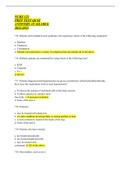
-
NURS 125 PREP TEST QUIZ ANSWERS AVAILABLE 2022-2023
- Exam (elaborations) • 141 pages • 2023
-
- $27.99
- + learn more
NURS 125 PREP TEST QUIZ ANSWERS AVAILABLE 2022-2023 715. Patients with irritable bowel syndrome will experience which of the following symptoms? a. Diarrhea b. Flatulence c. Constipation d. Patients can experience a variety of symptoms that can include all of the above. 716. Diabetic patients are monitored by using which of the following tests? a. KUB b. Troponin c. Fe++ d. HbA1C 717. Patients diagnosed with hypertension are given a medication called hydrochlorothiazide. How do...
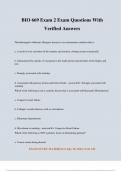
-
BIO 669 Exam 2 Exam Questions With Verified Answers
- Exam (elaborations) • 44 pages • 2024
- Available in package deal
-
- $14.49
- + learn more
BIO 669 Exam 2 Exam Questions With Verified Answers Thromboangiitis obliterans (Buergers disease) is an autoimmune condition that is: a. A result of over activation of the intrinsic and extrinsic clotting system systemically b. Characterized by attacks of vasospasm in the small arteries and arterioles of the fingers and toes c. Strongly associated with smoking d. Associated with janeway lesions and Oslers Nodes - answerc. Strongly associated with smoking Which of the following is not a ...

How did he do that? By selling his study resources on Stuvia. Try it yourself! Discover all about earning on Stuvia

